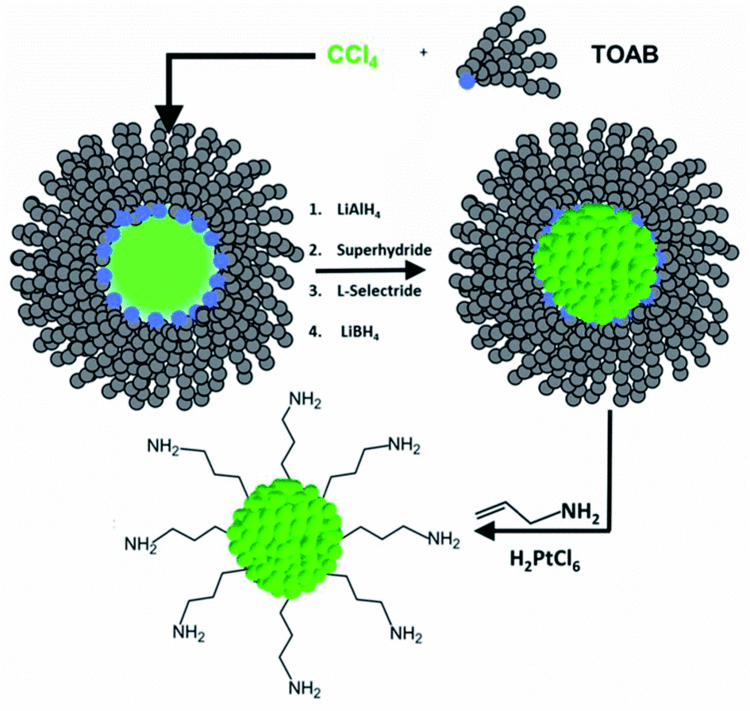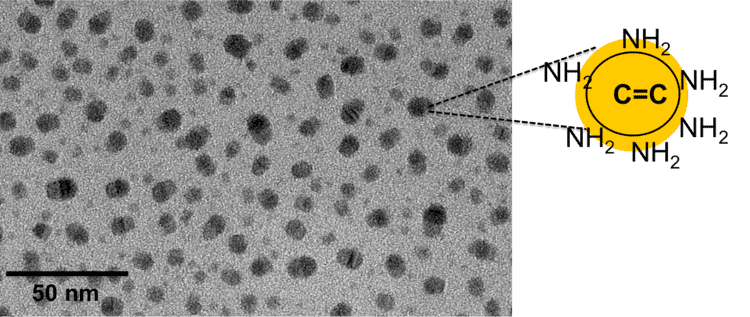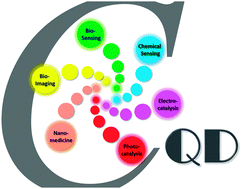 | ||
Carbon quantum dot

Carbon Quantum dots (CQDs, C-dots or CDs) are small carbon nanoparticles (less than 10 nm in size) with some form of surface passivation.
Contents
- Carbon quantum dot
- Properties of CQDs
- Synthesis of CQDs
- Synthetic methods
- Size control
- Modification
- Applications
- Bioimaging
- Sensing
- Drug delivery
- Catalysis
- Optronics
- References

CQDs were first discovered by Xu et al. in 2004 accidentally during the purification of single-walled carbon nanotubes. This discovery triggered extensive studies to exploit the fluorescence properties of CQDs. Much progress has been achieved in the Synthesis, properties and Applications of CQDs.

As a new class of fluorescent carbon Nanomaterials, CQDs possess the attractive properties of high stability, good conductivity, low toxicity, environmental friendliness, simple synthetic routes as well as comparable Optical properties to quantum dots. Carbon quantum dots have been extensively investigated especially due to their strong and tunable fluorescence emission properties, which enable their applications in biomedicine, optronics, catalysis, and sensing.

The fundamental mechanisms responsible of the fluorescence capability of CQDs are very debated. Some authors have provided evidence of size-dependent fluorescence properties, suggesting that the emission arises from electronic transitions with the core of the dots, influenced by quantum confinement effects, whereas other works have rather attributed the fluorescence to recombination of surface-trapped charges, or proposed a form of coupling between core and surface electronic states. The excitation-dependent fluorescence of CQDs, leading to their characteristic emission tunability, has been mostly linked to the inhomogeneous distribution of their emission characteristics, due to polydispersity, although some works have interestingly explained it as a violation of Kasha's rule arising from an unusually slow solvent relaxation.
Properties of CQDs

The structures and components of CQDs determine their diverse properties. Many carboxyl moieties on the CQD surface impart excellent solubility in water and biocompatibility. CQDs are also suitable for chemical modification and surface passivation with various organic, polymeric, inorganic or biological materials. By surface passivation, the fluorescence properties as well as physical properties of CQDs are enhanced.
Based on carbon, CQDs possess such properties as good conductivity, benign chemical composition, and photochemical stability.
Synthesis of CQDs
Synthetic methods for CQDs are roughly divided into two categories, "top-down" and "bottom-up" routes. These can be achieved via chemical, electrochemical or physical techniques. The CQDs obtained could be optimized during preparation or post-treatment. Modification of CQDs is also very important to get good surface properties which are essential for solubility and selected applications.
Synthetic methods
"Top-down" synthetic route refers to breaking down larger carbon structures such as graphite, Carbon nanotubes, and nanodiamonds into CDQs using laser ablation, arc discharge, and electrochemical techniques. For example, Zhou et al. first applied electrochemical method into synthesis of CQDs. They grew multi-walled carbon nanotubes on a carbon paper, then they inserted the carbon paper into an electrochemical cell containing supporting electrolyte including degassed acetonitrile and 0.1 M tetrabutyl ammonium perchlorate.
"Bottom-up" synthetic route involves synthesizing CQDs from small precursors such as carbohydrates, citrate, and polymer-silica nanocomposites through hydrothermal/solvothermal treatment, supported synthetic, and microwave synthetic routes. For instance, Zhu et al. described a simple method of preparing CQDs by heating a solution of poly(ethylene glycol) (PEG) and saccharide in 500W microwave oven for 2 to 10 min.
Recently, green synthetic approaches have also been employed for fabrication of CQDs.
Size control
To achieve uniform properties for particular applications and mechanic study, it is of great importance of control the size of CQDs during preparing process or via post-treatment.
A majority of the reports demonstrated the processes of purifying the as-synthesized CQDs fragments via post-treatment such as filtration, centrifugation, column chromatography and gel-electrophoresis.
In addition to post-treatment, controlling the size of CQDs during the preparing process is also widely used. For instance, Zhu et al. reported hydrophilic CQDs through impregnation of citric acid precursor. After pyrolyzing CQDs at 300 oC for 2 hours in air, then removing silica, followed by dialysis, they prepared CQDs with a uniform size of 1.5-2.5 nm which showed low toxicity, excellent luminescence, good photostability, and up-conversion properties.
Modification
Being a new type of fluorescent nanoparticles, applications of CQD lie in the field of bioimaging and biosensing due to their biological and environmental friendly composition and excellent biocompatibility. In order to survive the competition with conventional semiconductor quantum dots, a high quantum yield should be achieved. Although a good example of CQDs with ~80% quantum yield was synthesized, most of the quantum dots synthesized have a quantum yield below 10% so far. Surface-passivation and doping methods for modifications are usually applied for improving quantum yield.
To prevent surfaces of CQDs from being polluted by their environment, surface passivation is performed to alleviate the detrimental influence of surface contamination on their optical properties. A thin insulating layer is formed to achieve surface passivation via the attachment of polymeric materials on CQDs surface treated by acid.
In addition to surface passivation, doping is also a common method used to tune the properties of CQDs. Various doping methods with elements such as N, S, P have been demonstrated for tuning the properties of CQDs, among which N doping is the most common way due to its great ability in improving the photo luminescence emissions. The mechanisms by which Nitrogen doping enhances the fluorescence quantum yield of CQDs, as well as the structure of heavily N-doped CDs, are very debated issues in the literature.
Applications
Possessing such superior properties as low toxicity and good biocompatibility renders CQDs favorable materials for applications in bioimaging, biosensor and drug delivery. Based on the excellent optical and electronic properties, CQDs can also find applications in catalysis, sensors, and optronics.
Bioimaging
CQDs can be used for bioimaging due to their fluorescence emissions and biocompatibility. By injecting solvents containing CQDs into a living body, images in vitro can be obtained for detection or diagnosis purposes. One example is that organic dye-conjugated CQDs could be used as an effective fluorescent probes for H2S. The presence of H2S could tune the blue emission of the organic dye-conjugated CQDs to green. So by using a fluorescence microscope, the organic dye-conjugated CQDs were able to visualize changes in physiologically relevant levels of H2S.
Sensing
CQDs were also applied in biosensing as biosensor carriers for their flexibility in modification, high solubility in water, nontoxicity, good photostability, and excellent biocompatibility. The biosensors based on CQD could be used for visual monitoring of cellular copper, glucose, pH, and nucleic acid. A general example is about nucleic acid lateral flow assays. The discriminating tags on the amplicons are recognized by their respective antibodies and fluorescence signals provided by the attached CQDs. More generally, the fluorescence of CQDs efficiently responds to pH, local polarity, and to the presence of metal ions in solution, which further expands their potential for nanosensing applications, for instance in the analysis of pollutants.
Drug delivery
The nontoxicity and biocompatibility of CQDs enable them with broad applications in biomedicine as drug carriers, fluorescent tracers as well as controlling drug release. This is exemplified by the use of CQDs as photosensitizers in photodynamic therapy to destroy cancer cells.
Catalysis
The flexibility of functionalization with various groups CQDs makes them possible to absorb lights of different wavelengths, which offers good opportunities for applications in photocatalysis. CQDs-modified P25 TiO2 composites exhibited improved photocatalytic H2 evolution under irradiation with UV-Vis. The CQDs serve as a reservoir for electrons to improve the efficiency of separating of the electron-hole pairs of P25.
Optronics
CQDs possess the potential in serving as materials for dye-sensitized solar cells, organic solar cells, supercapacitor, and light emitting devices. CQDs can be used as photosensitizer in dye-sensitized solar cells and the photoelectric conversion efficiency is significantly enhanced. CQD incorporated hybrid silica based sol can be used as transparent Fluorescent paint,
